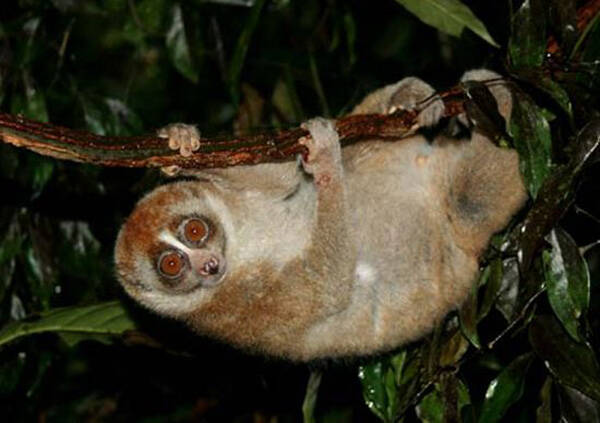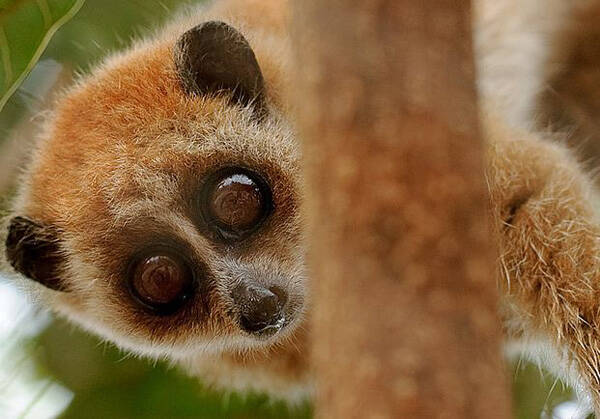Nycticebus coucan
IUCN
LCBasic Information
Scientific classification
- name:Nycticebus coucan
- Scientific Name:Nycticebus coucan, Greater Slow Loris、 Slow Loris、Sunda Slow Loris, Loris lent, Loris Lento,Middle Slow Loris
- Outline:Primates
- Family:S.loris
Vital signs
- length:27-38cm
- Weight:599-685g
- lifetime:About 10 years
Feature
The back is golden yellow, the snout is black, there is a white vertical stripe from the nose to the forehead, and the face is light in color.
Distribution and Habitat
Distributed in southern Sumatra south of the Batang Toru River in Indonesia, Batam and Galang Islands in the Riau Islands, Tebintinggi and Pangkoram Islands in the north of the Natuna Islands, Malaysia (Peninsular and Tioman Island), southern Thailand Peninsula, extending from the Isthmus of Kra southward to Tai Romyen National Park in northern Bangladesh and Singapore. It is the narrowest distributed species among Asian primates, with an estimated distribution range of less than 500 square kilometers.
The altitude of the slow loris is from sea level to 100 meters. It mainly inhabits primary and secondary tropical lowland forests. They also occur in the following habitats: tropical evergreen and semi-evergreen forests, seasonally moist or dry evergreen forests, tropical deciduous mixed forests, subtropical broadleaved montane forests, swamp forests, savannas, montane and submontane forests, shrublands, peat swamps and broadleaved forests, as well as degraded habitats such as highly
Appearance
The body length of the slow loris is 27-38 cm, and the weight is 599-685 grams. The body is larger than the Japanese slow-monkey but smaller than the Japanese slow-monkey. The upper body color is similar to the Japanese slow-monkey, but the white tips of the fur are obvious. They have a mostly white stripe between their eyes, starting near the top of their forehead and ending at the tip of their nose. Usually has light brown fur with a dark stripe down the back. Thick fur covers the ears. The remaining tail is hidden under the fur. Because they are mainly nocturnal, their eyes are large and bright like cat eyes. Their vision is very sensitive and they can identify objects in the dark, which is suitable for their living habits.
Their toes serve as powerful grippers: on their front toes, the second is smaller than the rest; on the back, the big toe is opposite the other toes, thus enhancing their gripping power. The second toe on its hind feet is curved and used for scratching and gro
Details
The slow loris (scientific name: Nycticebus coucan) is called Greater Slow Loris, Slow Loris, Sunda Slow Loris in English, Loris lent in French, Loris Lento in Spanish, and has 2 subspecies.

The slow loris is a typical arboreal animal in the tropical rainforest. It is nocturnal and rarely moves on the ground. It hides during the day and comes out at night. It is solitary and timid. During the day, it curls up into a ball and sleeps in a tree hole, on a branch or other hidden place. It comes out at night to look for food and moves slowly and silently. The species' locomotion resembles crawling, moving slowly through trees on all fours, with three limbs attached at any given time. They move with little sound or change in speed. At times, they may hang from one or two feet below branches for long periods of time. In captivity, locomotion includes quadrupedal locomotion (24%), climbing (21%), hanging (including cantilevering) (29%), bridging (23%), and other forms of locomotion (3%).
Slow lorises are primarily solitary, spending only 8% of their activity time in close proximity to other individuals. In cases of home range overlap, spatial groups form, typically consisting of a male, a female, and 1-3 young. Interactions between spatial groups are primarily positive: empathy, following, panting, and click-calling have all been observed. Despite this, only 3% of activity time is spent within spatial groups. This evidence may indicate a monogamous social system, although polygamous activity has also been observed.
When hunting, the loris not only relies on vision and smell, but also on very sharp hearing, which is extremely important for nocturnal animals. In fact, it often uses sound to find prey such as insects, birds, mice, frogs, snails, etc., and can show extremely high accuracy and rarely misses. Usually, it first patrols the surroundings vigilantly, and after finding the target, it approaches secretly, and then attacks with its front limbs unexpectedly to catch the prey. When eating, it mainly sits or climbs on branches, grabs the food with its hands, and slowly puts it into its mouth to chew, and never eats it in a hurry. Sometimes it will use its two hind legs to climb on the branches, grab the fruits below with its hands, and eat upside down. In the daily food intake of the loris, the proportion of animal food ranges from 10% to 85%, which shows that although it has a wide range of diet, it seems to prefer meat. It spends a lot of time hunting animals every night and eating some of its favorite fruits.
Although the loris always looks tired and slow, it has a strong climbing ability. Its thumb and index finger can form a 180-degree angle, and the palm is very flexible, so it has a unique grasping ability, which allows it to move between small branches and often relies on this ability to avoid danger.

Slow lorises usually do not live in groups. They live alone, whether foraging or living. Each male occupies an area of 20-30 hectares, with a maximum of 40 hectares. The female's territory is also about 10 hectares. In order to demarcate their own territory, slow lorises often smear the secretions from their wrist glands on trees or urinate on the border areas as a mark of their territory. Whenever other species enter their territory, they will mostly make harsh calls to warn and expel them, unlike the common phenomenon of beating each other in other animals.
The diet of slow lorises is very diverse, including various wild fruits, tender leaves, insects, snails, and even frogs, birds, mice, etc. It often takes sleeping birds out of their nests and swallows them with hair and bones. Of course, it will not let go of bird eggs. After breaking the eggshell, it will lick all the egg white and yolk with its tongue.
During the mating period of slow lorises, males track females in estrus, but females will initiate mating behavior. Initially, the female hangs on a branch within sight of the male, often making sounds to attract further attention. The male then grabs the female and the branch and copulates with it at the same time. Females may also use urine marking to seek mating. Males may produce a copulation plug after copulation. In observations of up to 6 species of intermedius, including females in estrus and 5 males. This may indicate a promiscuous mating system, where females mate with more than one male. There is no further evidence of polyandrous mating, but given their mating structure, this possibility is likely.
Intermedius is a polyestrous slow loris, with many sexually receptive periods in a year. Their estrous cycle lasts 29-45 days, and most matings occur consecutively. The gestation period averages 188 days, after which a single offspring is born, with twins occasionally occurring. The offspring are weaned between 3-6 months of age. Females mature sexually between 18-24 months, and males can reach sexual maturity as early as 17 months, although males usually mature around 20 months. Only females care for their young. Before and during weaning, females lick their pups, covering them in a toxic grease so that the pups may be protected while the females leave to forage. Females also provide examples, teaching the pups how to move through the woods.

The slow loris is listed as endangered and is under severe threat of hybridization with other invasive slow loris introduced into its native range due to past and ongoing habitat loss and past and ongoing hunting for the pet trade. The species in Sumatra is under intense pressure from the pet trade. Populations in Sumatra, Java, Singapore and Thailand have been severely affected by the invasion of other loris species, with the long-term effects suspected to be extremely negative for the species. Although the species can survive in plantations and home gardens, the increasing loss of key habitats throughout its range is suspected to have a significant impact on the species, with populations estimated to have declined by more than 50% in three generations (about 24 years), and given the continued threats to habitat and populations from hybridization and hunting, as of 2015, they are thought to continue to decline at the same rate over the next 20 years.
Listed in the IUCN Red List of Threatened Species (IUCN) 2015 ver3.1 - Endangered (EN).
Listed in Appendix I, Appendix II and Appendix III of the Convention on International Trade in Endangered Species of Wild Fauna and Flora (CITES) 2019 Edition.
Protect wild animals and eliminate game.
Maintaining ecological balance is everyone's responsibility!








